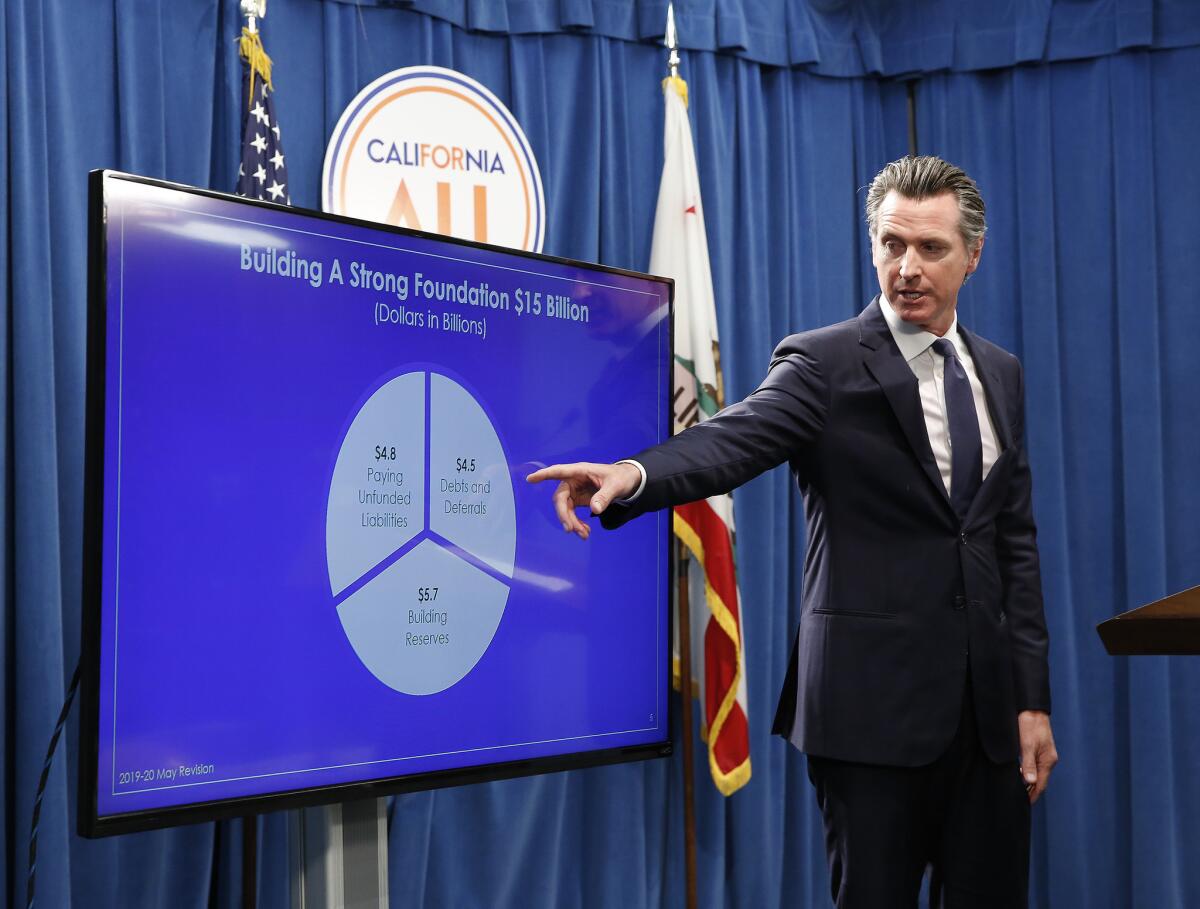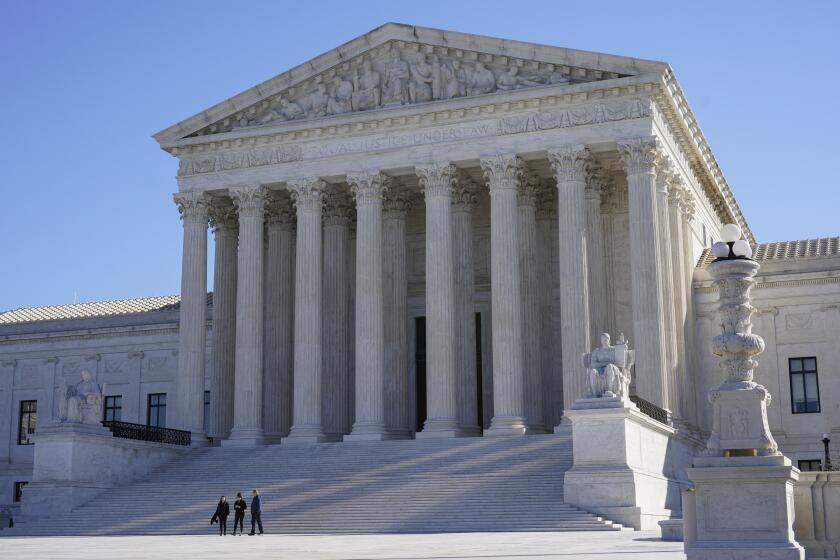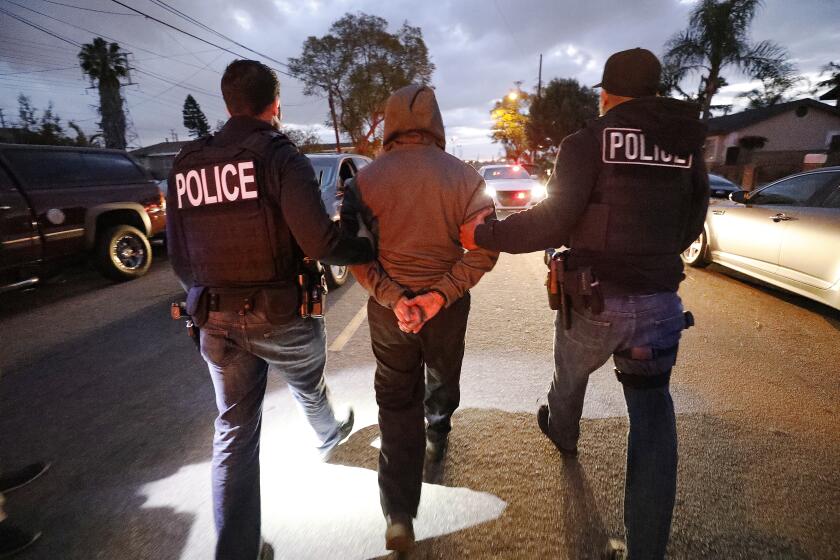Capitol Journal: California Gov. Gavin Newsom’s not-so-spectacular, not-so-horrible, OK state budget

- Share via
Reporting from Sacramento — Gavin Newsom has reached an important milestone in his reign as California’s rookie governor. He has produced his first state budget. So far, OK.
Nothing spectacular. Nothing horrible. But OK.
One hundred-day marks are irrelevant, especially for a California governor. That’s because of how the governing system and its deadlines are set up.
In truth, 100-day measurements haven’t meant much anywhere since President Franklin D. Roosevelt began swiftly expanding the federal government to fight the Great Depression at the start of his New Deal administration in 1933.
In Sacramento, the first six months provide the best initial measuring stick. The Legislature must pass a budget by June 15 and the governor should sign it by July 1, the start of the new fiscal year. Then you can grade them.
Maybe a generous B-minus so far for both Newsom and the Legislature.
One other thing: There’s an old maxim that for greatness to emerge, there must be a crisis. Abraham Lincoln and the Civil War. Roosevelt and the Depression. Winston Churchill and World War II.
California’s state government is in the opposite position of a crisis. It’s floating on a surplus of tax revenues that Newsom inherited. Things couldn’t be much better for the governor and Legislature.
California’s budget offers new help for millions — but with an expiration date »
The budget awaiting Newsom’s signature totals nearly $215 billion.
There’s a $21.5-billion surplus, compared with the $28-billion deficit former Gov. Jerry Brown inherited in 2011. Newsom is proud that he’s setting aside $19 billion in reserves. He’s also spending $3.3 billion to pay off what Brown labeled a “wall of debt.”
And $4 billion extra is going toward nudging down unfunded public pension and retiree healthcare liabilities — future fiscal landmines for the state and local governments that total into the hundreds of billions of dollars. Political leaders keep ignoring those.
The Legislature saved Newsom some headaches and probably defeats on a few budget items.
One was his proposed $1.7-billion income tax increase to finance a huge expansion of the state’s earned income tax credit for the poor. It needed a two-thirds majority vote. Moderate Democrats in the Assembly threatened to torpedo the measure.
The targeted taxes were complex and mostly paid by businesses. But one would have required employers to pay taxes on some fringe benefits for employees, such as parking subsidies, cafeteria food and Dodgers tickets. Employers could avoid the taxes by shedding the fringes.
The Legislature scrubbed that part of Newsom’s proposal. “It was too onerous on middle income earners,” one legislative staffer told me.
Just as important was a semantics tweak. The Newsom administration had billed the tax hike as a “federal conformity” measure to mesh state law with some features of President Trump’s 2017 tax overhaul.
Some Democratic legislators feared that a party rival might run against them in next year’s elections claiming they’d voted to conform California’s tax law to the unpopular Trump’s. So legislators simply changed the bill’s title to — get this — “The Loophole Closure and Small Business and Working Families Tax Relief Act of 2019.”
The tax conformity/loophole closure bill flew through both houses of the Legislature last week.
Newsom’s budget for California shows liberal Democrats are firmly in control »
Lawmakers also stepped in and saved the governor when he asked for a so-called water tax.
Newsom wanted $140 million to clean up toxic drinking water throughout California, most of it in low-income communities. His tax would be paid by residential, commercial and agricultural water users. But the bill needed a two-thirds vote. And imposing a new water tax when the state was sitting on a huge tax surplus had a terrible ring to it.
So lawmakers dipped into the fund created to fight greenhouse gas emissions and pulled out $133 million to cleanse water.
Other things Newsom has done in his first six months:
— Created a pool purchaser of prescription drugs for the state and local governments. The entity will negotiate volume deals with drug companies, who hate the idea.
— Offered Medi-Cal health insurance for young adult immigrants up to age 26 who are living here illegally and provided subsidies for middle-class families so they can buy medical insurance. But Newsom will require everyone to have health insurance or pay a penalty.
— Provided a second year of fee-free community college for full-time students. They already get the first year free.
— Declared a moratorium on the death penalty, which Californians have twice voted to retain.
— Scaled way back on Brown’s two controversial public works projects: the bullet train and Sacramento-San Joaquin River Delta water tunnels.
What Newsom hasn’t done: figured out how to create the home construction boom he promised as a candidate and to clean up the homelessness mess. That’s still being negotiated.
There’s widespread, muted criticism of Newsom for spending so much time on the road at photo ops while talking about a broad range of issues. He spreads himself too thin, they say. He should spend more time cajoling and coercing lawmakers while prioritizing and concentrating on a narrower set of urgent problems, as Brown did.
“He’s very insistent on getting out and about, interacting with everyday people, listening to what their struggles are,” senior advisor Daniel Zingale says. “He holds to the principle that he has to resist the gravitational pull to stay within the bubble.”
But why doesn’t he focus on just a few problems and make sure they’re solved? “He wants to do justice to as many things as he can while he has the privilege of being here.”
Check back in mid-October after he has signed or vetoed perhaps 1,000 bills. And we’ve had a wildfire season.
Follow @LATimesSkelton on Twitter
More to Read
Get the L.A. Times Politics newsletter
Deeply reported insights into legislation, politics and policy from Sacramento, Washington and beyond. In your inbox twice per week.
You may occasionally receive promotional content from the Los Angeles Times.










